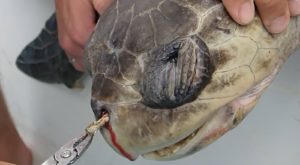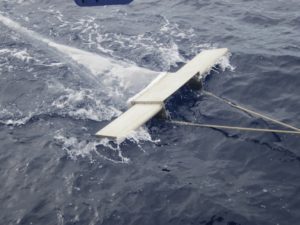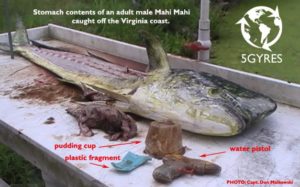Marine Ecosystems Under Duress No Thanks to Plastics

At the 3rd Annual Chesapeake Bay Foundation (CBF) meeting of Baltimore members, the featured speaker was Julie Lawson, who, as Executive Director, co-founded and is single-handedly leading the non-profit, Trash Free Maryland (TFMD).
On its home page is a recently recorded 3-minute video by actor Jeff Bridges: “When Did We Become a Plastic Society?” About 26M hits since March. Can be viewed here.

A few facts about the disposable plastics market in the U.S. –
- +500M disposable drinking straws are used in the U.S./person/day (that’s right, /day)
- One person consumes (uses) 400 water bottles/year on average
- 1,500 disposable plastic shopping bags are taken home by families/year on average
- Disposable plastic is consumed at the rate of 326 pounds/person/year on average
Doesn’t the image of the bleeding sea turtle make you want to say “no straw, please” in that next drink order you place??
If we do a much better job of choosing reusables (or declining), there’s a chance that our disposable plastic footprint can be nearly halved.
On dry land it’s a large problem too. The National Park Service initiated its “Be Straw Free” campaign several years ago. It says Americans use 1.6 disposable drinking straws/person/day so halving that part of our disposable plastics footprint shouldn’t be too difficult?
As to disposable water bottles, one place you might see ’em set aside for reusable ones is at schools and universities; particularly ones that are LEED Certified. In those places, the classic drinking fountain has a new feature: a place to refill your Nalgene or other reusable water bottle.
 Back to Ms. Lawson’s presentation. While focusing a share of her remarks on plastic microbeads (which ban in Maryland I blogged about in my tribute to Earth Day 2015), she passed around labeled jars of water taken from Baltimore’s Inner Harbor, the Chesapeake Bay and from the Chester River along Maryland’s Eastern shore. Though the jars are clear glass, the contents are anything but clear. In fact: disgusting.
Back to Ms. Lawson’s presentation. While focusing a share of her remarks on plastic microbeads (which ban in Maryland I blogged about in my tribute to Earth Day 2015), she passed around labeled jars of water taken from Baltimore’s Inner Harbor, the Chesapeake Bay and from the Chester River along Maryland’s Eastern shore. Though the jars are clear glass, the contents are anything but clear. In fact: disgusting.
These jars were exhibited around the Maryland General Assembly during its recently concluded annual 90-day session. A bill banning plastic shopping bags, The Community Cleanup and Greening Act, was proposed with strong support from TFMD and other non-profits such as Blue Water Baltimore and the Interfaith Partners for the Chesapeake.
There were other major environmental initiatives under consideration, such as raising significantly the statewide goal for GHG emissions reduction, increasing the renewable energy mandate, and banning a particular household garden chemical proved harmful to pollinator bee reproduction. Lawson said these initiatives and several others filled to the spilling point the “environmental plate” of the legislators, so the bill banning plastic shopping bags risked losing the rest.
Here’s a brief video about microplastics at the TFMD website–
When held up to the light, microplastic can be seen actually attached to the detritus captured in the water samples. Chemical pollutants in water, such as from fertilizer, “sorb” to microplastic debris, making this a cocktail the more toxic for marine life tissue and organ absorption.
 The detritus is “caught” for examination by what’s called a manta trawl net. Cast behind a moving boat, the trawl remains at the surface of the water, hydroplaning on its wings like a manta ray while a net of mesh as small as 333 microns trails behind to capture what’s at or near the water’s surface.
The detritus is “caught” for examination by what’s called a manta trawl net. Cast behind a moving boat, the trawl remains at the surface of the water, hydroplaning on its wings like a manta ray while a net of mesh as small as 333 microns trails behind to capture what’s at or near the water’s surface.
 Here’s an image of the detritus ingested by a mahi-mahi off the coast of Virginia.
Here’s an image of the detritus ingested by a mahi-mahi off the coast of Virginia.
But, Ms. Lawson is not alone in her work to ban plastic shopping bags and impose a 10¢ fee on paper bags in Maryland. Partner organizations of TFMD are over 60, ranging from the Blue Water Baltimore, the CBF and Chesapeake Climate Action Network to Interfaith Partners for the Chesapeake, the Port Tobacco River Conservancy and the Wicomico Environmental Trust.
Also helping the cause are 2 solar water wheel skimmers that extract trash at the Inner Harbor outfalls of the Jones Falls and Harris Creek. I blogged here about this curiously-designed contraption back in September 2014.
So, remember…

P.S. We just became a donor to the worthy efforts of Trash Free Maryland.